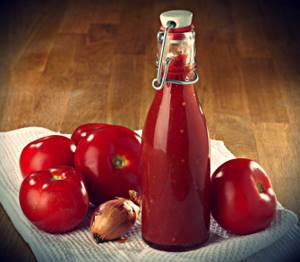Properties of ketchup
Nutritional value and composition | Vitamins | Minerals
How much does ketchup cost (average price for 1 kg)?
Moscow and Moscow region.
90 rub.
Ketchup is considered a truly universal condiment because it can be used with a wide variety of dishes - pasta, sandwiches, hamburgers, pizza, all kinds of hot and cold dishes, as well as salads.
It is interesting that this product has its culinary origins back in the 17th century, when a certain sauce called “ke-tsiap” or “koechiap” was brought from Asia to England, which translated meant “brine based on salted fish or shellfish.” It should be noted that initially the ketchup recipe did not include the use of tomatoes - the sauce was prepared from walnuts, anchovies, beans and mushrooms, which were mixed with wine, garlic and spices.
In general, the official homeland of ketchup is called the USA, and in England it was first called “catchup”, after which this name was transformed into the more familiar “ketchup”. At the end of the nineteenth century, tomatoes began to be added to ketchup, which helped the sauce become even more popular.
In addition to the store-bought product, ketchup can also be easily made at home, using fairly ripe and very juicy red tomatoes and various spices (mustard seed, nutmeg, allspice, cinnamon, ginger, cloves and many others).
Composition and calorie content of ketchup
Today, the composition of ketchup is no longer a secret to anyone - tomatoes in combination with spices and vinegar - this is what should appear on the packaging of a high-quality tomato sauce. It is also allowed to add sugar, salt, garlic and other natural products that cannot harm health in any way.
Ketchup is approximately 70% water and 25% carbohydrates. It contains a small amount of fats and proteins, vitamins PP, K, E, B9, C, B6, B1, B2, B5, A, beta-carotene; minerals: fluorine, selenium, manganese, copper, zinc, potassium, calcium, magnesium, sodium.
The calorie content of ketchup is low and is approximately 100 kcal per 100 g of product.
Types of ketchup
Depending on the culinary use, there are several types of ketchup:
- tomato ketchup;
- kebab ketchup;
- hot ketchup (chili);
- spicy ketchup;
- ketchup for national dishes.
All these types of ketchup are usually classified into 4 categories, which depend on the production method and technology. Thus, the highest quality product is considered to be in the “Extra” category, which is produced exclusively from fresh tomatoes or tomato paste with natural additives. Next come ketchups of the highest, first and second categories, which contain a small proportion of dyes, stabilizers and thickeners.
Harm and dangerous properties
Natural ketchup, made from high-quality products, without the addition of chemicals, can be dangerous for people prone to allergies, as there is a risk of allergic reactions due to the inclusion of various spices and spices in its composition. Pregnant women are also not advised to abuse this product, as it can trigger the development of allergies in newborn babies.
Of course, people who suffer from problems with the digestive system should not consume tomato sauces, especially those with the addition of hot pepper. When used even in small quantities, it can provoke attacks of gastritis and peptic ulcers.
Recent studies in the field of childbirth have shown that the tomato concentrate from which ketchups are made contains harmful substances. They negatively affect the male body in terms of reproduction. Therefore, families planning a child are not recommended to eat this product.
A huge amount of dyes, thickeners, preservatives and other various food additives contained in low-quality tomato sauces, if consumed regularly, can lead to irreparable damage to the body. It has been proven that they can even cause cancer.
The high sugar content and modified starch contained in ketchup will be harmful for people with metabolic disorders and those who are overweight.
In Russia, ketchup is prohibited for school meals and meals in secondary and vocational education institutions.
The benefits of ketchup
Rarely does anyone talk about the benefits of ketchup, which, although not unreasonable, is not entirely true. The fact is that a natural, high-quality product contains a substance called lycopene, which gives vegetables their red color. It has a clear antitumor effect and reduces the risk of heart disease.
In addition, the benefits of ketchup for a person’s mental balance are justified, because this product contains serotonin - the “happiness hormone”. Therefore, we can call this sauce a natural antidepressant.
What to give preference
Of course, a quality product. The ideal option would be one that contains only tomato paste, spices, salt, water and vinegar. In premium and extra-class sauces, the tomato content is approximately 40-50%, in the highest category ketchups - it does not exceed 30%, but if not more than 15%, then this is economy-class ketchup, unfortunately the most common product in our stores. Adding acetic acid to a high-quality sauce is quite acceptable and will not harm the body, since it is contained there in small doses, which is absolutely harmless.
The color of ketchup also plays an important role. It should be remembered that during heat treatment the bright red color of tomatoes darkens somewhat, so if you have a product in front of you that is unnaturally red, then not a lot of tomato paste was used during its preparation. And most likely, dyes and preservatives were used here. If the color is too dark, you should also be wary - this ketchup probably contains additives in the form of plum or applesauce.
Consistency can also be used to judge the quality of the product. You need to pay attention to the fact that it is quite thick, and no gurgling sounds appear when shaking the bottle. If you buy ketchup in glass containers, you should note that there are no gas bubbles. Good quality ketchup does not spread when served and should be a thick, bulky mass.

The best packaging not only for this sauce, but for any others, is still glass. It is environmentally friendly and does not emit any harmful substances. In addition, the product is visible through it, which allows you to immediately assess its quality.
In general, when purchasing ketchup in stores, you should carefully study the product label. A high-quality natural sauce should not contain:
- dyes;
- preservatives;
- sweeteners;
- flavor enhancers;
- thickeners;
- any food additives labeled E;
- fruit or vegetable puree;
- starch.
It is advisable to pay attention to the fact that the product complies with GOST. And of course, it is worth remembering that a high-quality product prepared using standard technology and a classic recipe will have a fairly high price.
Making ketchup at home
The safest ketchup for consumption is the one you prepare at home. You can be sure of the quality of the products used, the preparation technology and the environmental friendliness of production.
To prepare you will need:
- tomatoes - 2 kg;
- sweet red pepper - 500 grams;
- onion - 500 grams;
- sugar - 1 glass;
- salt;
- vegetable oil - 200 grams;
- ground black pepper - 1 tablespoon;
- mustard - 1 tablespoon.
Pass all ingredients through a meat grinder, add spices and mix. Let it cook for about an hour and a half. You can taste the prepared sauce before sending it to cook. Some people like it spicy, some like it spicy. At this stage, it is possible to add hot chili peppers, garlic, and various other spices that seem necessary. It is possible and even necessary to experiment in the process of preparing sauces, because it is in this way that you can prepare a unique, incomparable, exclusive dish.
Application
Ketchup is used both in the preparation of hot and cold dishes, and as an independent sauce for ready-made dishes. The United States is rightfully considered the country that ranks first in the consumption of ketchup; it is there that ketchup is most common in the preparation of so-called fast food.
- Black Lives Matter movement: reaction and consequences for the beauty industry
- COVID-19 is changing the rules of the game in the cosmetics market
- Beauty of the future: cosmetic innovations 2021
Convenient search for beauty salons on our website
Beauty salons in Moscow Beauty salons in St. Petersburg Beauty salons in Ekaterinburg Beauty salons in Novosibirsk
Latest blog posts on our website
- Naturecream / Tremella Extract - Snow Mushroom Detox for Skin
- Prostye-sovety / How to visually enlarge your lips with makeup
- Naturecream / Apricot kernel oil for face
- Naturecream / MATRIXYL3000 - the best skin elasticity stimulator
- Naturecream / SPF in Natural Oils
- Naturecream / Geranium (Pelargonium) oil for skin health and beauty
- Prostye-sovety / Save on a beauty salon: procedures that can be done at home
- Naturecream / Growth Factor - brings back youth?
- Oksana-Lezina / 3 effective abdominal exercises from a fitness instructor for beginners
- Prostye-sovety / Making perfect curls at home
Latest forum topics on our website
- Natalya / How to properly make a gelatin mask?
- Mrs._Smith / Badly sunburned! What to do?((
- Ice / Is it necessary to combine fitness classes with a diet?
- Antonova / What can be used for hair loss?
- Radio operatorKat / Who was on a protein diet?
Other articles in this section
| Adjika Adjika is a spicy Caucasian seasoning in the form of a paste containing garlic, salt, red pepper and various herbs. It is often red in color, but can be green when using unripe peppers. According to one version, the word “adzhika” is translated from Abkhazian as “red salt”, according to another – as “bread with salt”. |
| Ground black pepper is the most revered and sought after spice in the world. It has long grown exclusively in India and Greece, where it was especially in demand and loved. In ancient times, pepper did not serve only as a seasoning, but was used as money. In Ancient India it was sacred, and the ancient Greeks appeased the Gods with it. One of the reasons to use ground pepper in cooking is its ability to freshen a dish and give it a special spice and aroma. |
| Ginger Ginger is an exotic perennial plant native to tropical and subtropical climates. The countries of Southeast Asia are considered to be its historical homeland. Currently, industrial plantations of cultivated ginger are located in China, India, Indonesia, Australia and some West African countries. A rare type of ginger is grown in Jamaica, which has a unique delicate aroma. |
| Raw sugar Raw sugar is a unique, incompletely processed, easily digestible food product. It tastes sweet, most often of cane origin, less often made from sugar beets, as it has an unpleasant aftertaste and lower content of microelements. Available in light brown, gray and white colors. |
| Zira Zira - seeds of the herb cumin, which belongs to the parsley family, is sold in the form of oblong-shaped grains. In many countries it is usually called by its Latin name; in our country it is called the same as in the East. This seasoning has been known since ancient times, but has gained great popularity in oriental cuisine for medicine. The history of the use of cumin goes back many centuries. It is often confused with caraway seeds, which are similar in appearance to cumin grains. Due to its specific taste, it is often used as a seasoning for bread and meat dishes. |
| Granulated sugar Granulated sugar is a bulk food product and is sucrose. In appearance, these are individual small crystals ranging in size from 0.3 to 2 mm. |
| Saffron The spice that can be called the most expensive in the world is saffron. For its production, exclusively the stigmas of crocus flowers are used, which are crushed for this purpose. |
| Vanillin For the vast majority of people, vanillin is a crystalline powder with a specific rich vanilla aroma. The demand for vanilla is much higher than the possibility of obtaining a natural product. Therefore, people had to use chemical reactions to reproduce artificial vanillin to satisfy all the needs. |
| Ground white pepper The pepper vine, which gives us black pepper, which is indispensable in cooking and beloved by everyone, also provides another tasty seasoning - white pepper. In fact, these are the same fruits of the same plant. Only to obtain black pepper are they picked green and unripe. And white pepper can only be prepared from fully ripened fruits that have gained the strength of their red color. |
| Coriander Coriander is an annual herbaceous plant belonging to the Apiaceae family. Even the ancient Greeks treated it with great respect and considered it a medical remedy. Later, thanks to the Romans, coriander was discovered in England and Western Europe. Then he ended up in America and then in India. |
Recipes with ketchup

This universal seasoning can be added to any dish: hot, cold, snacks. Less commonly, salads and desserts are prepared with it, and it is used in baking, but this use is becoming increasingly popular.
Recipes for delicious dishes with ketchup:
- Chinese salad
. Chicken fillet (200 g) is boiled for 2-3 minutes, placed in cold water. This way the meat will remain juicy. Chop red cabbage (200 g), mix with salt (1 tsp), leave for 15 minutes. While the fillet is cooling in the water and the cabbage is being salted, make sauces. To prepare the first, mix 100 g of ketchup, 30 ml of soy sauce, honey - 30 g, sesame oil - 10 ml until smooth. For the second, whisk sesame oil (2 ml), peanut butter (70 g), soy sauce (10 ml), water (2 tbsp.). The chicken is thinly sliced into noodles, divided in half, each part is separately packaged in cling film, wrapped tightly and put in the freezer for 15 minutes. To the cabbage add 15 g of half rings of red sweet onion and 2 tbsp. l. red sauce. Mix and place on a plate in the form of a nest. Pour fillet pieces into the cavity, generously pour peanut dressing, and pour the remaining red sauce over the cabbage. One thing to keep in mind is that the chicken is undercooked. Therefore, the dish is not offered to children and people with digestive dysfunction. - Liver salad
. 0.5 kg of chicken liver is fried in sunflower oil, cut into pieces and salted. Place on a paper towel to remove excess fat. The leaf part of 1 fork of Chinese cabbage is finely chopped. 1 avocado is peeled, cut into slices, placed on cabbage, and sprinkled with the juice of 1 lemon. Add liver, chopped boiled eggs (5 pieces), and tomato slices (5 small pieces) to the cabbage salad bowl. Dressing: yogurt (5 tbsp), ketchup (2 tbsp), cognac (1 tbsp). Salt and pepper - to taste. - Cookie
. To knead the dough, add pieces of frozen butter (100 g) to 160 g of sifted premium wheat flour and grind into crumbs. Stir in grated cheese (80 g), 1.5 tablespoons of hot ketchup and the same amount of mayonnaise, beat in 1 egg. The mixture is rolled into a ball, left for 40 minutes in the refrigerator, and then rolled into a layer. Cut the cookies and bake at 180°C until golden brown (about 15 minutes). Before putting in the oven, you can sprinkle with pepper, herbs or sesame seeds.
See also recipes for dishes with teriyaki sauce.
Calorie content of sauces
Sauce is a liquid, jelly-like or thickened food additive that is used to improve the taste of dishes. Despite the fact that sauces are not used so often in the kitchen in everyday life, they are an integral addition to almost every dish!
Calorie content of sauces
| calorie content per 100 grams | calorie content 1 tablespoon (15–20 g) | calorie content 1 teaspoon (5–7 g) | |
| Soy sauce calories | 50 kcal | 7.5–10 kcal | 2.5–3.5 kcal |
| Calories in tomato sauce | 80 kcal | 12–16 kcal | 4–5.6 kcal |
| Calorie content of ketchup | 95 kcal | 14–19 kcal | 5–7 kcal |
| Calories in cream sauce | 468 kcal | 70–94 kcal | 23–33 kcal |
| Calorie content of mayonnaise | 560 kcal | 84–112 kcal | 28–40 kcal |
| Bechamel sauce calories | 230 kcal | 35–46 kcal | 12–16 kcal |
| Calorie content of tkemali | 410 kcal | 61–82 kcal | 20–29 kcal |
| Calorie content of satsebeli | 65 kcal | 10–13 kcal | 3–5 kcal |
| calories in mushroom sauce | 85 kcal | 13–17 kcal | 4–6 kcal |
| Tartar sauce calories | 464 kcal | 70–90 kcal | 23–32 kcal |
| Calories in Chili Sauce | 120 kcal | 18–24 kcal | 8–9 kcal |
Soy sauce
Soy sauce is known to everyone, primarily thanks to sushi bars.
In addition to being used as a seasoning for sushi, the sauce is widely used to improve the taste of mushroom, meat and fish dishes. Due to its low calorie content, soy sauce is included in some diets, winning this right over almost all other sauces.
The disadvantages of this sauce include the widespread production of the product from synthetic ingredients, due to which consumers may experience allergic reactions, dermatitis and problems with the gastrointestinal tract.
Tomato sauce
Such a low calorie content of tomato sauce is due to the use of completely natural plant ingredients: fresh tomatoes and other vegetables, spices, salt.
The sauce is used as a dressing for soups and other hot dishes, as a gravy for meat dishes or as a spread for snacks. The famous Italian dish “pasta” is also not complete without the use of tomato sauce.
Thanks to the use of natural vegetables, the sauce contains many useful substances and vitamins: lycopene, vitamins C, B1 and PP.
The harmful properties of tomato sauce include the fact that although the calorie content is low, this does not mean that the sauce can be eaten in large quantities - there must be a certain norm. In addition, tomato sauce may cause heartburn.
Cream sauce
This sauce is much higher in calories than tomato and soy sauce due to the use of animal fats for cooking. Thanks to the use of flour and fermented milk products to prepare this sauce, its moderate consumption has a beneficial effect on the general condition of the body. Some cosmetologists even prescribe masks, the composition of which is almost similar to the composition of the sauce.
Vitamin content
| Vitamins | Content | Daily norm |
| C (ascorbic acid) | 4.1 mg | 5.86 % |
| A (retinol) | 26 mcg | 2.6 % |
| E (α-, β-, γ-tocopherols) | 1.46 mg | 14.6 % |
| B1 (thiamine) | 0.01 mg | 0.73 % |
| B2 (riboflavin) | 0.17 mg | 9.22 % |
| B3 (PP) (nicotinamide) | 1.43 mg | 7.55 % |
| B4 (choline) | 12.5 mg | 2.5 % |
| B6 (pyridoxine) | 0.16 mcg | 7.9 % |
| B9 (folacin) | 9 mcg | 4.5 % |
Ketchup contains vitamins with high, medium and low levels when considered according to the approved standards for the nutritional value of the product.
At the highest level of importance in the food value chain is vitamin E, which keeps the muscular system in good shape.
Vitamins at a medium level of importance include:
- C, takes part in the redox processes of the body, raises the tone of the body, strengthens the immune system.
- B2, maintains body tone.
- PP, participates in the formation of hemoglobin.
- B6, participates in the metabolism of lipids and amino acids.
Vitamins of low content include:
- A, takes part in all functions of the body related to its growth and proper metabolism, preserves the structure of the cornea of the eye.
- B1, required to normalize the nervous and muscular systems.
- B4, is involved in the biosynthesis of heme and proteins, cell proliferation, and tissue respiration.
- B9, supports the hematopoietic and digestive system.
Calculation of caloric content of a product per 100 grams
The calculation of the calorie content of 100 grams of product is based on previously known indicators of BZHU (abbreviation: proteins-fats-carbohydrates). The calculation method is the summation of these data (obtained by laboratory analysis and calculations) previously multiplied by a value equal to the energy released (calories) during their splitting. So, for example, 1 gram of protein or carbohydrate can release energy equal to 4.1 kcal, and fat a little more than 9. In calorie calculations, these numbers are usually rounded to whole numbers, as is the result itself.
Our example involves proteins - 1 gram, fats - 0.1 grams and carbohydrates - 27.1 grams contained in 100 grams of product. Next we perform the calculation:
Energy value of 100 grams = 1 (proteins)*4 + 0.1 (fat)*9 + 27.1 (carbohydrates)*4 = 4 + 0.9 + 108.4 = 113.3 kcal
Our calculated calorie content is more than 50, but less than 250 kcal, which means that ketchup is a medium-calorie product with an average carbohydrate content and a low level of protein and fat.
Various processing methods
When eating dietary dishes, you need to at least somehow diversify their taste. What is traditionally present in a regular weight loss menu? In addition to vegetable salads, the main list consists of rather bland dishes: porridge, rice, potatoes, boiled chicken, fish. Therefore, I want to refresh the food with some savory additions. You can prepare a huge variety of dishes from tomatoes. Let's look at the main options for getting some of them. Tomatoes are usually processed in two ways:
- First. Squeezing fresh ripe fruits to remove skins and seeds and obtain tomato juice. The result is a liquid, which is then boiled for a short time and sealed in jars, usually without adding any additional components. The calorie content of tomato juice will be almost equal to that of fresh tomatoes.
- Second. Pre-boiling the cut fruits and then pureeing them to obtain a puree. This semi-finished product is the basis for making other tomato dishes - pasta and sauces.
Historical perspective

Before deciding whether you can eat ketchup while losing weight, you should find out where such a product even came from, who created it and offered it for consumption. There is a version that ketchup first appeared in 1830, when an enterprising farmer originally from New England not only sold tomatoes, but offered them to customers in grated form.
It was very convenient to use and store the product in this way, and therefore the method quickly spread, and very soon other farmers began to use it. Over time, small enterprises appeared that produced ketchup, but the original product did not have substitutes, preservatives, sweeteners, and a huge number of synthetic and very hazardous components. The composition contained tomatoes and salt.
In 1900, there were already more than a hundred ketchup manufacturers in North America who supplied their goods to the domestic market. However, the country's borders did not delay the product for long. Convenient and practical packaging allowed ketchup to “travel” on ships, and therefore it quickly migrated to Europe and other countries. Today it is impossible to imagine fast food cafes, restaurants serving American, Asian, and Mexican food without such an additive. But whether it is possible to eat ketchup on a diet is not entirely clear.











